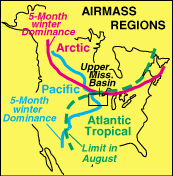Summary:

|
Figure 1. Main air masses that affect the climate of North America. The Atlantic-Gulf air mass dominates during the summer, and the Arctic and Pacific air masses battle it out during the winter.
|
|
The carbon cycle in lakes in the Upper Mississippi River Basin (Wisconsin, Minnesota, and North and South Dakota) is being studied as part of the USGS interdivisional Mississippi Basin Carbon Project. This region of North America has provided some of the most detailed records of changes in climate that occurred during the Holocene (last 10,000 years). This region is particularly sensitive to climate change because it is located at the intersection of the Gulf of Mexico, Pacific, and Arctic air masses that control the climate of North America (Figure 1). Changes in the interactions of these air masses can produce climate changes on decadal, millennial, and even longer time scales, and these changes can be rapid and extreme. Lakes more than any other terrestrial ecosystem have the greatest potential for preserving continuous, undisturbed records of climate and environmental change. Lakes are complex ecosystems in themselves, but they also reflect and integrate many biosphere/geosphere feedback processes that occur in their watersheds and airsheds. The biogeochemcial cycles associated with these processes are recorded in the sediments of lakes. Cores of lake sediments provide the long time-series for documentation of Holocene paleoclimatic and paleoenvironmental changes. This will be accomplished by detailed, multidisciplinary investigations of biological, sedimentological, and chemical characteristics of lake sediments. Lakes in the glaciated regions of the Upper Mississsippi Basin have a wide range of chemical (acid to alkaline; dilute to saline), biological (ologotrophic to eutrophic), and hydrological (open to closed basins) attributes. Therefore they are ideal localities to compare and contrast effects anthropogenic and natural environmental/climatic changes in carbon cycling, and the inter-relationships between carbon cycling and the biogeochemical cycles of other elements. Through analyses of carbon and other elements we intend to relate changes in biogeochemical processses of production, decomposition, preservation, and burial of carbon in lakes with a variety of chemical and biological characteristics, and changes in these processes with time.
Objectives:
The main objectives of the research on linked biogeochemical cycles in lake sediments is to (1) understand climate variability on carbon burial in lakes on time-scales ranging from inter-annual to thousands of years; (2) develop geochemical techniques for use in paleoclimatic, and paleolimnologic reconstructions; (3) determine the sources and sinks of carbon and other elements and how the effectiveness of those sources and sinks varied under different climate regimes of the past; (4) investigate the processes that determine the distribution of carbon and other elements in lake sediments; and (5) investigate changes in the terrestrial carbon cycle; biogeochemical interactions with the hydrologic cycle; biogeochemical controls over the transport of water, nutrients, and materials from land to freshwater ecosystems, and from freshwater ecosystems to sediment reservoirs.
Selected Publications:
Bradbury, J.P. and Dean, W.E., eds., 1993, Elk Lake, Minnesota: Evidence for rapid climate change in north-central United States: Boulder, Colorado, Geological Society of America, Special Paper 276
Schwalb, A., Locke, S. M., and Dean, W. E., 1995, Ostracode d18O and d13C evidence of Holocene environmental changes in the sediments of two Minnesota Lakes: Journal of Paleolimnology, v. 14, p. 281-296.
Dean, W. E., Ahlbrandt, T. S., Anderson, R. Y., and Bradbury, J. P., 1996, Regional Aridity in North America during the middle Holocene: The Holocene, v. 6, p. 145-155.
Dean, W. E., 1997, Rates, timing, and cyclicity of Holocene eolian activity in north-central United States: Evidence from varved lake sediments: Geology, v. 25, p. 331-334.
Dean, W. E., and Gorham, E., 1998, Magnitude and significance of carbon burial in lakes, reservoirs, and peatlands: Geology, v. 26
Schwalb, A. and Dean, W. E., 1998, Stable isotopes and sediments from Pickerel Lake, South Dakota, USA: Journal of Paleolimnology (in press)
Dean, W. E., 1998, The carbon cycle and biogeochemical dynamics in lake sediments: Journal of Paleolimnology (in press)
For more information contact
Walter E. Dean.
|

